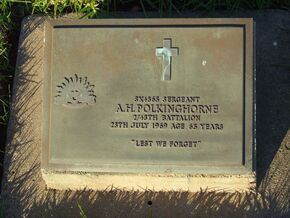POLKINGHORNE, Alfred Herbert
| Service Number: | SX4865 |
|---|---|
| Enlisted: | 8 June 1940, Adelaide, SA |
| Last Rank: | Sergeant |
| Last Unit: | 2nd/48th Infantry Battalion |
| Born: | Goodwood, South Australia, 11 June 1904 |
| Home Town: | Whyalla (Formerly Hummock's Hill), Whyalla, South Australia |
| Schooling: | Not yet discovered |
| Occupation: | Labourer |
| Died: | 28 July 1969, aged 65 years, cause of death not yet discovered, place of death not yet discovered |
| Cemetery: |
Centennial Park Cemetery, South Australia Derrick Gardens in Path 13 Plot 776A. |
| Memorials: | Gawler Council WW2 Honour Roll, Williamstown & District WW2 Honour Roll |
World War 2 Service
| 8 Jun 1940: | Involvement Sergeant, SX4865 | |
|---|---|---|
| 8 Jun 1940: | Enlisted Adelaide, SA | |
| 8 Jun 1940: | Enlisted Australian Military Forces (WW2) , Sergeant, SX4865, 2nd/48th Infantry Battalion | |
| 1 Feb 1946: | Discharged | |
| 1 Feb 1946: | Discharged Australian Military Forces (WW2) , Sergeant, SX4865, 2nd/48th Infantry Battalion |
Mentioned in Despatches
On the 11th June 1904, Alfred was born in the Adelaide suburb of Goodwood to Charlotte Louise and Alfred Polkinghorne, after whom he was named. He was one of three brothers with his siblings being an older brother, John Richard and younger, Ronald Franz.
Prior to the commencement of WWII Alfred was living in Whyalla, a fast-growing town originally called Hummock’s Hill, where ore was being mined in the Iron Knob area. The town had become a thriving deep-sea harbour with a blast furnace was built in ’39. A ship building yard was then constructed near the blast furnace, all of which needed many workers, including Alfred who gained work as a labourer.
Alfred travelled to Clare in the mid-north where he enlisted on the 8th June 1940, just prior to his 36th birthday, becoming SX4865. His early training began in Woodside in the Adelaide Hills where he was initially placed in the 7th Division Petrol Company. However, by September he was serving with the newly formed 2/48th Battalion.
By November that year he was on the Stratheden sailing for the Middle East where he arrived on the 17th December. Unfortunately, in the confined conditions at training camp, Alfred contracted mumps and spent over a week in hospital. On returning to his battalion, his maturity and leadership skills resulted in a series of rapid promotions through Corporal to Sergeant over seven months. Accompanying this was his attendance at Infantry School undertaking a necessary Mortar Course where he excelled in the theory and knowledge aspect of the course, but his quiet voice was considered less effective for him to become an instructor.
By August ’41 Alfred was in the Salient in hot, dusty conditions. John Glenn in Tobruk to Tarakan described these as ‘a wind like the breath of a furnace, and the nights were bathed in the light of a full moon.’ This made it extremely difficult for ration parties to get meals out through gaps in the minefields with a constant barrage of Spandau fire, answered by Bren.
In one incident near the Water Tower Wadi two soldiers from a fellow battalion had been badly wounded and were lying in No Man’s Land ‘through the heat of a North African mid-summer day without cover of any kind. An ordeal for an unwounded man, but sheer hell for men wounded as they were. Headquarters received word that the wounded were to be brought in, and volunteers were called for ‘to go forward in a vehicle and meet the party coming in. Sergeant Polkinghorne, Ike Jenkinson (SX7997) and Billy Hook (SX7124) volunteered, and moved forward; they came under machine gun fire, but succeeded in bringing the wounded out.’
Resultantly, Alfred was Mentioned in Despatches on the 30th December ’41. This honour was described as ‘being mentioned in despatches’ occurred with many soldiers during the fighting in the Middle East, and although there are numerous higher forms of recognition for bravery, this particular one requires no small amount of courage and devotion to duty under arduous conditions. A fitting summary of the rescue undertaken by Alfred and his partners.
By February ’43 the 2/48th Battalion had become one of the highly respected and decorated groups who certainly had earned their return to Australia via Melbourne.
Training in Queensland followed at the battalion prepared to face a very different enemy in the tropical conditions of New Guinea. By August ’43 Alfred had arrived at Milne Bay. Unfortunately, within four months he had contracted malaria but recovered to continue serving until his return to Brisbane in February the following year. The toll on his body, particularly his feet meant that Alfred spent the last of his army days at Atherton in Queensland. He had developed an infection in his right ankle from an injection. Aged 41, Alf was finally discharged on the 1st February ’46 and returned to live at Forestville. Apart from his car having a collision with a motor bike ridden by two Broken Hill men in February ’49, Alf lived a quiet life. His name now appears on the Memorial gates at the Whyalla Memorial Oval.
His father lived to be 97 and died on the 8th March ’68. The following year, aged 65, Alfred died on the 28th July 1969. Fittingly, he was buried in the Derrick Gardens at Centennial Park cemetery in Path 13 Plot 776A.
Researched and written by Kaye Lee, daughter of Bryan Holmes SX8133, 2/48th Battalion.
Submitted 28 October 2024 by Kaye Lee










